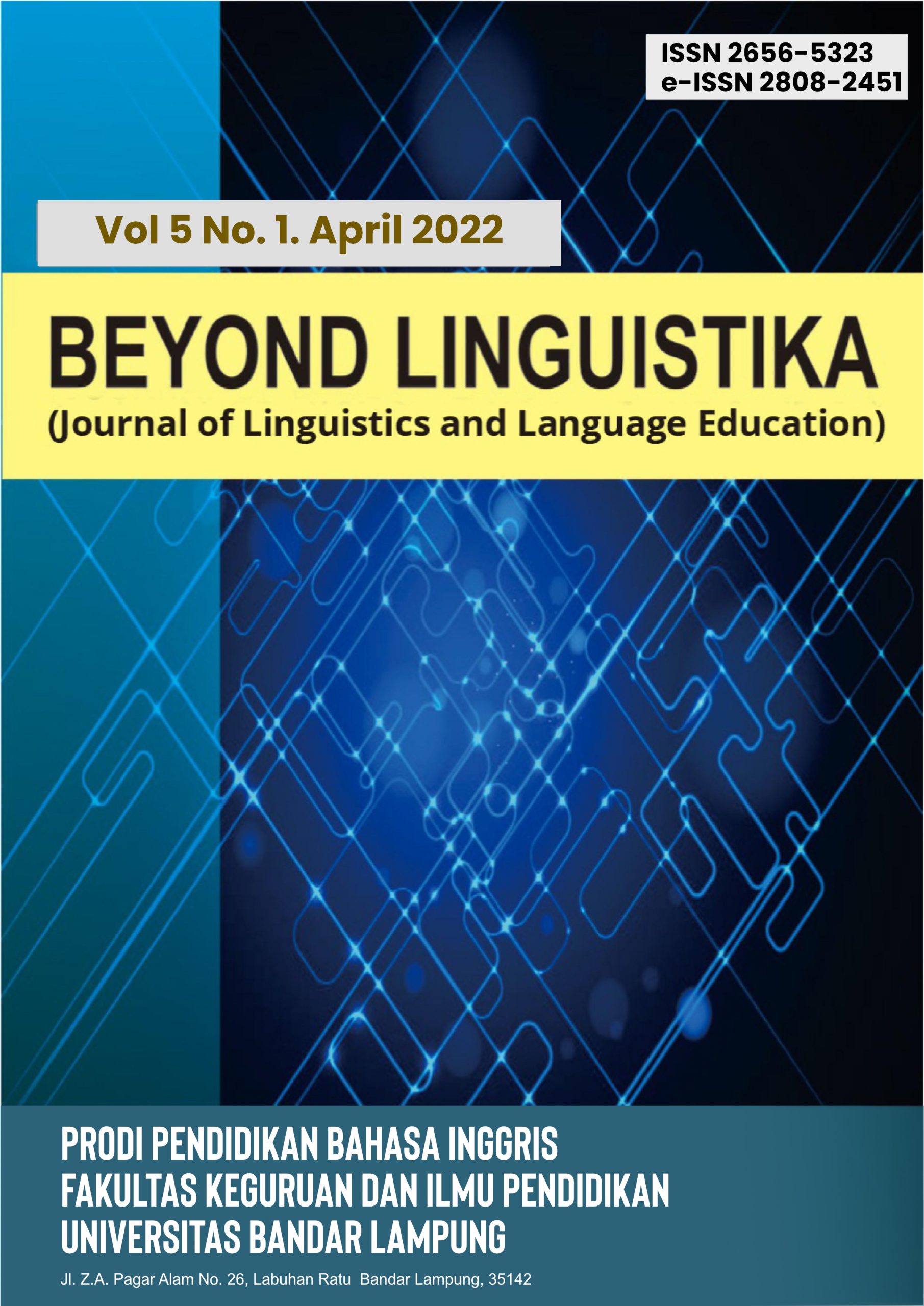STUDENTS’ PERCEPTION IN LEARNING EXTENSIVE LISTENING BY USING CARTOON MOVIES
Abstract
Extensive listening is a way to practice listening skill thoroughly. Listening to various recordings, videos, and interviews on the same topic will help to get context in a real situation, and will help to learn more vocabulary. The objective of this research was to find out students’ perceptions in learning extensive listening by using cartoon movies. This study used a qualitative method. The research was done at SMK Trisakti Jaya Bandar Lampung for the 10th grade students (N=38). Data gathering was done by conducting observation, questionnaire and interview. The result showed that they agree learning English through extensive listening by using cartoon movies as the listening materials help them a lot to develop their listening skill. Based on the observations, questionnaires and interviews, it can be concluded that most of the students think that it is very helpful, and faster for them in learning English with extensive listening technique. Most students thought that learning extensive listening by using cartoon movies can be carried out in the learning process.
Keywords
Full Text:
PDFReferences
Asmawati, A. (2017). Analyzing students’ difficulties toward listening comprehension. ETERNAL (English, Teaching, Learning, and Research Journal), 3(2), 211–228. https://doi.org/10.24252/ETERNAL.V32.2017.A9
Bogdan, R. C., & Biklen, S. K. (1998). Qualitative Research for Education: An introduction to theory and methods (3rd ed.). Boston, MA: Allyn and Bacon.
Creswell, J. W. (2014). Research Design: Qualitative, quantitative, and mixed methods approaches (4th ed.). Thousand Oaks, CA: SAGE Publications.
Febriyanti, M., & Susanto, S. (2017). The use of digital storytelling narrative text to improve students speaking ability at Grade Ten SMAN 2 Bandar Lampung. Linguistika, 8(1), 31–37. Retrieved from http://jurnal.ubl.ac.id/index.php/Linguistika/article/view/1382
Ghoneim, N. M. M. (2013). The listening comprehension strategies used by college students to cope with the aural problems in EFL classes: An analytical study. English Language Teaching, 6(2), 100–112. https://doi.org/10.5539/elt.v6n2p100
Hapsari, Y., & Ratri, D. P. (2014). Extensive listening: Let students experience learning by optimizing the use of authentic materials. Jurnal Pendidikan Bahasa Dan Sastra, 14(2), 251–259. https://doi.org/10.17509/BS_JPBSP.V14I2.723
Hidayat, A. (2013). The use of songs in teaching students’ listening ability. Journal of English and Education, 1(1), 21–29. Retrieved from https://ejournal.upi.edu/index.php/L-E/article/view/322/211
Ivone, F. M., & Renandya, W. A. (2019). Extensive listening and viewing in ELT. TEFLIN Journal, 30(2), 237–256. https://doi.org/10.15639/teflinjournal.v30i2/237-256
Izzah, L. (2014). Implementing song in teaching listening comprehension at Muhammadiyah University of Jakarta. MORPH, 1(2), 1–13. https://doi.org/10.5281/zenodo.1216173
Johnson, R. B., & Christensen, L. (2014). Educational Research: Quantitative, qualitative, and mixed approaches (5th ed.). Thousand Oaks, CA: SAGE Publications.
Kenny, D. A. (2004). PERSON: a general model of interpersonal perception. Personality and Social Psychology Review, 8(3), 265–280. https://doi.org/10.1207/s15327957pspr0803_3
Macrae, C. N., & Bodenhausen, G. V. (2001). Social cognition: Categorical person perception. British Journal of Psychology, 92(1), 239–255. https://doi.org/10.1348/000712601162059
Markus, H., Smith, J., & Moreland, R. L. (1985). Role of the self-concept in the perception of others. Journal of Personality and Social Psychology, 49(6), 1494–1512. https://doi.org/10.1037/0022-3514.49.6.1494
Nanda, D. S., & Susanto, S. (2020). Using literary work as authentic material for the EFL classroom in Indonesia. International Journal of Innovation, Creativity and Change, 12(12), 1057–1064. https://doi.org/10.31219/OSF.IO/CJRWT
Nanda, D. S., & Susanto, S. (2021). Using drama in EFL classroom for exploring students’ knowledge and learning. English Review: Journal of English Education, 9(2), 285–292. Retrieved from https://journal.uniku.ac.id/index.php/ERJEE/article/view/4353/2563
Patahuddin, P., Syawal, S., & Bin-Tahir, S. Z. (2017). Investigating Indonesian EFL learners’ learning and acquiring English vocabulary. International Journal of English Linguistics, 7(4). https://doi.org/10.5539/ijel.v7n4p128
Rakhman, F. A., Tarjana, S. S., & Marmanto, S. (2019). Indonesian English department students listening difficulties and listening strategies. IJER (Indonesian Journal of Educational Research), 4(2), 60–67. https://doi.org/10.30631/IJER.V4I2.113
Sadiku, L. M. (2015). The importance of four skills reading, speaking, writing, listening in a lesson hour. European Journal of Language and Literature, 1(1), 29–31. https://doi.org/10.26417/EJLS.V1I1.P29-31
Tarnopolsky, O. (2013). Developing ESO students English speaking, reading, listening, and writing skills in internet-assisted project work. Journal of Teaching English for Specific and Academic Purposes, 1(1), 11–20. Retrieved from http://espeap.junis.ni.ac.rs/index.php/espeap/article/view/28
Tyagi, B. (2013). Listening: An important skill and its various aspects. The Criterion An International Journal in English, 12(1), 1–8. Retrieved from https://the-criterion.com/V4/n1/Babita.pdf
DOI: http://dx.doi.org/10.36448/bl.v5i1.2649
Refbacks
- There are currently no refbacks.















